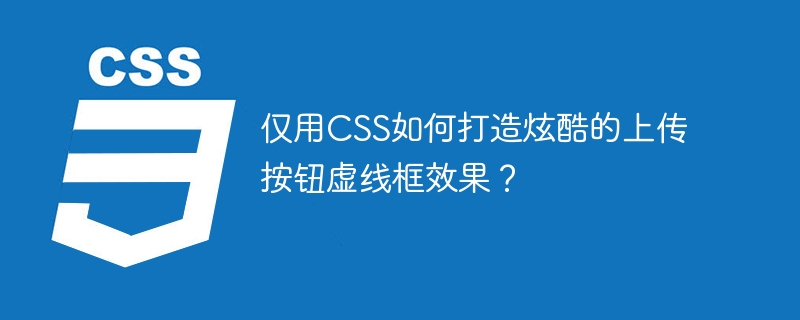 Web Front-end
Web Front-end
 CSS Tutorial
CSS Tutorial
 How to create a cool dotted box effect of upload buttons using CSS alone?
How to create a cool dotted box effect of upload buttons using CSS alone?
How to create a cool dotted box effect of upload buttons using CSS alone?
Apr 05, 2025 pm 10:24 PMPure CSS creates a cool dotted box effect of upload buttons! Say goodbye to pictures and JavaScript, you can achieve it with just CSS code! This article will demonstrate how to use CSS linear gradients to create a unique upload button style, the effect is as shown in the example image.

Many developers want to design a more attractive look for upload buttons. Traditional methods usually rely on images or complex JavaScript code, but in fact, we can easily achieve similar effects by cleverly applying the linear-gradient attributes of CSS.
The secret is to skillfully superimpose two linear gradients. By adjusting the gradient direction, size and repetition, we can simulate the visual effect of the dotted frame. The following CSS code shows the specific implementation:
label {
display: block;
width: 80px;
height: 80px;
border: 1px dashed #ccc;
background: linear-gradient(#ccc, #ccc) center/40px 4px no-repeat,
linear-gradient(#ccc, #ccc) center/4px 40px no-repeat;
}
Code interpretation:
-
widthandheightproperties define the button size. -
borderproperty sets the dotted border. -
backgroundproperty is the core, which superimposes two linear gradients:-
linear-gradient(#ccc, #ccc) center/40px 4px no-repeat: Create a short dotted line in the horizontal direction. -
linear-gradient(#ccc, #ccc) center/4px 40px no-repeat: Create a short dotted line in the vertical direction. The two combine to form a grid-like dotted frame. -
center/40px 4pxandcenter/4px 40pxcontrol the size and position of the gradient, thereby accurately controlling the length and spacing of the dotted lines.
-
You can adjust width , height and color values ??(such as #ccc ) as needed to customize the button size and appearance. By modifying the linear-gradient parameter, you can further fine-tune the dotted line effect, such as adjusting the thickness and spacing of the dotted line.
The above is the detailed content of How to create a cool dotted box effect of upload buttons using CSS alone?. For more information, please follow other related articles on the PHP Chinese website!

Hot AI Tools

Undress AI Tool
Undress images for free

Undresser.AI Undress
AI-powered app for creating realistic nude photos

AI Clothes Remover
Online AI tool for removing clothes from photos.

Clothoff.io
AI clothes remover

Video Face Swap
Swap faces in any video effortlessly with our completely free AI face swap tool!

Hot Article

Hot Tools

Notepad++7.3.1
Easy-to-use and free code editor

SublimeText3 Chinese version
Chinese version, very easy to use

Zend Studio 13.0.1
Powerful PHP integrated development environment

Dreamweaver CS6
Visual web development tools

SublimeText3 Mac version
God-level code editing software (SublimeText3)

Hot Topics
 How to achieve the rotation effect of element
May 23, 2025 pm 11:21 PM
How to achieve the rotation effect of element
May 23, 2025 pm 11:21 PM
To achieve the rotation effect of an element, use JavaScript combined with CSS3's transform attribute. 1. Use transform's rotate() function to set the rotation angle. 2. Realize dynamic rotation through requestAnimationFrame. 3. Consider reducing DOM operations or using CSS animations when optimizing performance. 4. Ensure browser compatibility and add prefixes. 5. User interactive control rotation is achieved through mouse or touch events.
 How to use the new semantic tags (such as section, article) in HTML5?
May 23, 2025 pm 11:36 PM
How to use the new semantic tags (such as section, article) in HTML5?
May 23, 2025 pm 11:36 PM
The reason we use semantic tags is that they improve SEO, enhance accessibility, and code maintainability. 1. Include titles when using them to avoid abuse. 2. Use stand-alone content blocks, suitable for blogs or news. 3. Pay attention to the nesting and SEO of tags, and do not pile up tags for SEO.
 How can I include the CSS with React?
May 26, 2025 am 12:01 AM
How can I include the CSS with React?
May 26, 2025 am 12:01 AM
There are five ways to include CSS in React: 1. Use inline styles, which are simple but not conducive to reuse and maintenance; 2. Use CSS files, which are implemented through import, which are conducive to organization but may lead to conflicts; 3. Use CSSModules to avoid global conflicts but require configuration; 4. Use StyledComponents to dynamically generate styles using JavaScript but require dependency on libraries; 5. Use Sass or Less to provide more functions but increase construction complexity.
 How can I include CSS only on some pages?
Jun 11, 2025 am 12:01 AM
How can I include CSS only on some pages?
Jun 11, 2025 am 12:01 AM
There are three ways to selectively include CSS on a specific page: 1. Inline CSS, suitable for pages that are not frequently accessed or require unique styles; 2. Load external CSS files using JavaScript conditions, suitable for situations where flexibility is required; 3. Containment on the server side, suitable for scenarios using server-side languages. This approach can optimize website performance and maintainability, but requires balance of modularity and performance.
 CSS Inclusion Methods: Pros, Cons, and Examples
Jun 07, 2025 am 12:03 AM
CSS Inclusion Methods: Pros, Cons, and Examples
Jun 07, 2025 am 12:03 AM
ThedifferentmethodsforincludingCSSinawebpageareinline,internal,andexternalCSS.1)InlineCSS:Easytoimplementbutleadstounmaintainablecode.2)InternalCSS:MoreorganizedthaninlinebutcanclutterHTML.3)ExternalCSS:Bestforlargerprojects,promotesmaintainabilityan
 HTML, CSS, and JavaScript: How They Work Together
May 27, 2025 am 12:05 AM
HTML, CSS, and JavaScript: How They Work Together
May 27, 2025 am 12:05 AM
HTML, CSS and JavaScript are responsible for structure, style and dynamic functions in web development respectively. 1. HTML defines the web structure, 2. CSS is responsible for style and layout, 3. JavaScript provides dynamic interaction and functions.
 Best Practices for Including CSS in Your Website
May 24, 2025 am 12:09 AM
Best Practices for Including CSS in Your Website
May 24, 2025 am 12:09 AM
ThebestpracticesforincludingCSSinawebsiteare:1)UseexternalCSSforseparationofcontentandpresentation,reusability,andcachingbenefits.2)ConsiderusingCSSpreprocessorslikeSassorLessformodularity.3)OptimizeperformancewithCSSminificationandcompression.4)Stru
 How to deal with CSS and Case-sensitivity
May 25, 2025 am 12:02 AM
How to deal with CSS and Case-sensitivity
May 25, 2025 am 12:02 AM
CSSismostlycase-insensitive,butselectorsandcustompropertiesarecase-sensitive.1)Useconsistentcasingconventions.2)EmploylinterslikeStylelint.3)Testacrossbrowsers.4)Bemindfulofexternalresources'conventions.Consistentcasinghelpsmaintaincodecleanlinessand





